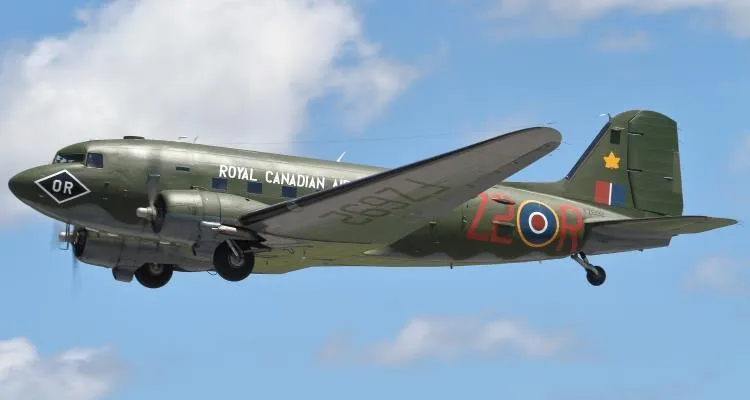Douglas Dakota Skytrain C-47 DC-3 AC-47 R4D Spooky Gooney Bird

Canadian Warplane Heritage Museum
Development of the Douglas DC-3 started in early 1935 with the prototype flying by the end of the year. The first production aircraft was delivered to American Airlines in July 1936 and soon orders were pouring in from US and overseas airlines. The US Air Corps became interested in the DC-3 and ordered a military version, called the C-47 or Dakota. It had many capabilities, including dropping paratroops and supplies, evacuating the wounded, troop transportation and glider towing. Eventually, about 10,000 C-47s were built for the US military.
During WW II, the Royal Air Force received about 1,930 Dakotas and they became the RAF's main wartime transport aircraft. The RCAF took delivery of its first Dakota in March 1943, and at its peak had 169 on strength. Within Canada, they were operated by four transport squadrons and several ferry squadrons.
Overseas, Dakotas equipped RCAF 437 Squadron in Europe and RCAF 435 and 436 Squadrons in South East Asia. 437 Squadron was formed in England September 1944, where it supported the British and Canadian Armies fighting in Europe. Its most important actions involved glider towing for the airborne landings at Arnhem and the Rhine crossing at Wesel.435 and 436 Squadrons were formed in India in October 1944. They flew Dakotas in support of the British 14th Army in Burma where they dropped supplies to the British troops fighting the Japanese in the jungle.
At the end of WW II, all three squadrons were transferred back to England to provide air transport for the Canadian occupation forces in Germany. Dakotas continued in service with the Canadian Armed Forces until 1989, when 402 Squadron, based in Winnipeg, retired the last of them. Of the nearly 13,000 DC-3s built, many are still in service today, over 75 years after the aircraft's first flight.
The Museum's Dakota was built for the USAAF and was delivered to the Royal Air Force in February 1944 as FZ692 and the Royal Canadian Air Force 437 Squadron in September 1944. It was later renumbered as 12945 as part of the Canadian Armed Forces where it served with 424 Squadron for Search & Rescue at CFB Trenton. It performed JATO ignition in flight at the 1970 Canadian National Exhibition Air Show on the Toronto waterfront.
After it was struck off strength by the Canadian Armed Forces in 1973, the aircraft ended up with Environment Canada, where it was used for mineral and environmental surveys. C-GRSB was donated to the Canadian Warplane Heritage Museum in May 2014.
FZ692 has been restored to the paint scheme it would have worn at the end of World War II with 437 Squadron RCAF. FZ692 flew 208 operational trips with 437 Squadron and 16 with 233 Squadron for a total of 224. It ended up flying hundreds of individual legs between airfields in Europe. FZ692 participated in two major airborne operations, Normandy and the Rhine Crossing. It carried 298 casualties to medical aid and repatriated 456 prisoners of war. It carried over 5,100 passengers to destinations around Europe and carried over two hundred tons of freight (414,368 lbs). CWHM
 Canada Aviation Museum Dakota Overview
Canada Aviation Museum Dakota Overview
CASPIR Aircraft Groups:
RCAF On Strength (212), RCAF 400 Squadron (6), Canadian Aircraft Losses (99), Canadian Museum(1)Dakota III FL650
Ex USAAF C-47A-1-DK, serial number 42-92294. To No. 32 Operational Training Unit at RCAF Station Patricia Bay, BC. Went missing at sea on night flight, 17 March 1944. Took off at 19:40, last radio contact at 21:58. All 3 crew never found: pilots Pilot Officer J.B. Murphy, RAFVR and Sgt. D. Oliver, RAF; and wireless operator Sgt. R.A. Hodge, RNZAF, veteran of 17 operations with Bomber Command. Two oxygen cylinders of a type used on this aircraft were later recovered in the Pearse Island Group, northern Vancouver Island.
1944-01-31 Taken on Strength 2019-08-20
1945-06-12 Struck off Strength Written off, after going missing, see comments;
NB: SOS date changed from 06 Nov/44 to 12 June/45 per Griffin source material. 2020-09-28





 Library and Archives Canada Service Files (may not exist)
Library and Archives Canada Service Files (may not exist) Wellington City, New Zealand
Wellington City, New Zealand

 C-47 Skytrain
C-47 Skytrain Wikipedia C-47 Skytrain
Wikipedia C-47 Skytrain Harold A Skaarup Web Page
Harold A Skaarup Web Page Dakota Maintenance Manual
Dakota Maintenance Manual RCAF.info - Patricia Bay, British Columbia
RCAF.info - Patricia Bay, British Columbia